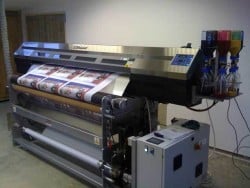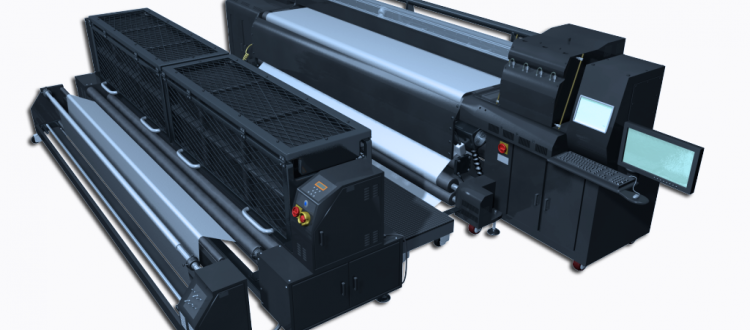Printing from dye sublimated dyes to regular inks, and finding a good dye sublimation printer.
Question: Can a printer be used for Dye Sublimation after already having been used with regular inks?
No. The two types of printers are mutually exclusive to the types of material that are being printed.
First, traditional dye sublimation printing of cloths and fabrics is done with a CMYO ink set, which is different from CMYK. The CMYO (“O” stands for the clear overprint) printing is printed to a transfer paper, and then applied to the fabric using heat and pressure. The “O” then becomes the black, so the net result is CMYK.
Newer dye sub printers use a CMYK print configuration as they are direct-to-fabric printing, but they are still different inks than what you would print vinyl banners or decals with. The chemical formulation of the inks used for direct dye sub printing are specifically for synthetic materials such as nylon or polyester.
Question: Hi. I’m looking for suggestions on a dye sublimation printer?
 Are you looking for the printer itself, or are you looking for a printer that prints using dye sublimation?
Are you looking for the printer itself, or are you looking for a printer that prints using dye sublimation?
Unit of Printer
I’ll answer both questions. First, if you want a printing unit, I would suggest only looking at Japanese or Korean printers, and stay away from the rest. This would include many good makes, including Seiko, Mimaki, and Canon, to name a few.
Avoid these Printers
Secondly, I would steer clear of printers that use the older method of dye sub printing as elucidated in the above question. Direct-to-fabric or cloth dye sublimation printing is much less complicated with much less chance for expensive errors.
How to Find that Dye Sublimation Printer
Now, if you’re looking for a dye sublimation fabric or cloth banner or display printer, a company that actually does the printing, this will be a different subject, as you’re talking about the company itself as well as the printers they use.
1. Ask for the printers that they actually use.
First, ask what printers are being used. Printers manufactured, for instance, in India or China are currently simply not up to snuff when it comes to print quality. The inks are sub-par, which in turn creates sub-par appearing banners. I’ve seen this first hand, and it’s not pretty.
2. Do a background check of the company.
Second, the quality of the company itself should be investigated. Google the name of the company, and go at least 10 pages deep on Google. If there are no complaints on consumer watchdog sites like the Better Business Bureau website, or sites like ComplaintBoard.com or RipOffReport.com, then you can predict that this is a good company.
3. Check any complaints while also looking at the company’s point of view.
If there is a complaint, though, do read the company point of view. There are occasional clients who have unrealistic expectations, and no one could please them. This reminds me of my friend and colleague, Bob, who had a client who wanted his colors to be super specific. After several tries at printing the right color, Bob, exasperated, finally said to the client, “John, I simply cannot get any closer than this to the color you want!” To which John responded. “Oh, OK….well, I’m color-blind anyway, so just go with these colors then! Doh!
One Last Thing to Do
The last thing you can do, when seeking a company to work with, is to request samples. Some companies will send them free of charge, while others will charge a nominal fee to print the file on the correct banner fabric ahead of time, then refund the fee when the order is placed. And some simply charge for a prototype, with nothing refunded on the order. You can choose which company you prefer when going through the quote process.
Check this out for dye sub printing of banners of vinyl and fabric types. Also, feel free to leave your thoughts or any questions you have on the comment form below.
Popular Posts:




